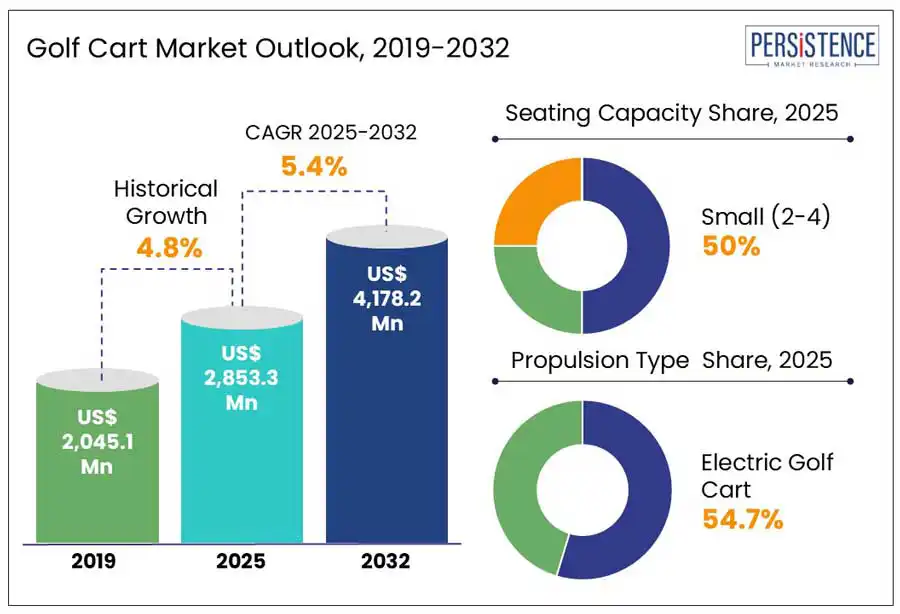Comprehensive Analysis of Golf Cart Market Including Regional and Country Analysis in Brief.
Industry: Consumer Goods
Published Date: April-2025
Format: PPT*, PDF, EXCEL
Delivery Timelines: Contact Sales
Number of Pages: 185
Report ID: PMRREP35204
The global Golf Cart market size is anticipated to rise from US$ 2,853.3 Mn in 2025 to US$ 4,178.2 Mn to witness a CAGR of 5.4% by 2032. Growing number of golf courses and country clubs, rise in of sports enthusiasts, and an increase in purchasing power are some of the factors driving the demand growth for golf carts in the global market. Golf cart manufacturers are integrating features such as lithium-ion batteries, GPS tracking, Bluetooth connectivity, and USB charging ports into modern golf carts, enhancing their appeal to both golf courses and individual consumers.

Key Industry Highlights:
|
Global Market Attribute |
Key Insights |
|
Golf Cart Market Size (2025E) |
US$ 2,853.3 Mn |
|
Market Value Forecast (2032F) |
US$ 4,178.2 Mn |
|
Projected Growth (CAGR 2025 to 2032) |
5.4% |
|
Historical Market Growth (CAGR 2019 to 2024) |
4.8% |
Golf carts are used for different purpose such as utility vehicles and mobility cars in small communities, large apartment complexes, and university campuses. Golf carts are used for transporting light cargo and facilitates on-time logistics. Since they traverse easily on grass, they can be used on smooth terrains to effectively move goods. Golf carts are equipped with utility beds to deliver props and equipment to sports teams at stadiums. At railway stations and airports, they facilitate carriage movement. Therefore, these factors encourage the use of golf carts in the coming years.
One significant factor is regulatory restrictions. Many regions have strict laws governing where golf carts can operate, limiting their use beyond golf courses. For example, in some areas, golf carts are prohibited on public roads unless modified to meet safety standards, reducing their appeal as a versatile transportation option.
Another constraint is the high initial cost of purchasing a golf cart. While prices vary, a quality electric golf cart can range from $5,000 to $15,000. This expense may deter potential buyers, particularly those who view golf carts as luxury items rather than necessities. Additionally, the market is influenced by competition from alternative transportation methods. Electric bikes and scooters, which offer similar convenience for short-distance travel, are gaining popularity. This shift can divert consumer interest away from golf carts.
Customized golf carts and rental services have been prominent over the last few years due to an increase in the number of golf courses in the country and also due to the increasing use of golf cart vehicles at hotels, hospitality industry, tourism industry, and amusement parks. These carts support government's initiative to promote tourism. The growing preference for low-speed vehicles in several industries are expected to help the market grow steadily in the forecast period.
A golf cart is a small motorized vehicle that is widely used to carry passengers and other golf equipment across golf courses. Golf surged in popularity in 2021 by nearly every metric, as people sought socially-distanced outdoor activities amid the pandemic. The U.S. is one of the best countries in the world to play golf, which means that there is a large number of golf courses across the country. This is thereby driving the demand for golf carts in the country. The golf club segment is projected to create an absolute opportunity of US$ 454.8 Mn in the forecast period.
Electric golf carts are projected to create an opportunity of US$ 1097.1 Mn between 2025 and 2032. Golf carts are available in the gasoline as well as electric forms. Electric golf carts and gasoline golf carts both have their advantages and disadvantages. However, since the world is moving toward sustainability and EVs are trending in the market, EV golf cart shares are rapidly increasing in the United States.

North America led the global golf cart market in 2024, reaching a market size of $1.01 billion, and is expected to stay ahead in the coming years. The United States plays a key role accounting for 73% share. This is largely due to the country's strong golfing culture and large number of golf courses (over 16,000). In 2024, about 26.6 million Americans played golf, with a growing interest in the sport.
The market is also growing beyond golf courses. Golf carts are now widely used in resorts, airports, universities, retirement communities, and gated neighborhoods for easy, low-speed transportation. The U.S. golf cart market is benefiting from favorable low-speed vehicle regulations, which are encouraging broader use of golf carts for transportation. Electric models are becoming especially popular due to rising environmental awareness.
Europe held a second-large share of the global golf cart market in 2024, driven by the growth of golf tourism an increasing number of elderly communities, and expanding golf infrastructure. The popularity of golf is growing steadily, especially in developed countries such as the United Kingdom, Germany, France, and Spain. Northern and Western Europe have a well-established golfing presence, while Southeastern and Central Europe are emerging markets. The region shows a clear preference for electric golf carts, in line with Europe’s strong focus on environmental sustainability.
Tourism and commercial use are major growth drivers, with golf carts being used in resorts, hotels, and leisure communities. Europe is also home to several luxury golf cart manufacturers, catering to high-end consumer preferences. The U.K. leads the European market, holding around 29% share in 2024. With over 3,100 registered golf facilities, it is a leading market in Europe.
Asia Pacific is expected to experience a strong CAGR over the forecast period. The growth is fueled by increasing awareness and participation in golf across emerging countries along with the rapid development of new golf courses. Countries such as Japan, China, India, Australia, and New Zealand are driving demand not only in traditional golf settings but also in commercial spaces such as airports, resorts, and gated communities.
The region is witnessing a notable shift toward electric golf carts, supported by growing environmental concerns and efforts to adopt sustainable transport solutions. Rising golf tourism and a growing middle-class population with an interest in leisure sports have further boosted demand. The market is also shaped by increased investments in luxury resorts and recreational facilities.
Japan emerges as the leading market in the Asia Pacific, with over 3,140 golf courses. The country's mature golfing culture, advanced infrastructure, and strong presence of major manufacturers such as Toyota contribute to its dominant position. Japan’s focus on innovation and sustainability, especially in electric vehicle technology, continues to drive market growth. Overall, the Asia Pacific golf cart market is evolving rapidly with significant potential for expansion in the coming years.
The global golf cart market is highly competitive, characterized by the presence of several key players striving to enhance their market share through product innovation, strategic partnerships, and geographic expansion. Leading companies such as Yamaha Golf-Car Company, Club Car, and E-Z-GO (a Textron company) dominate the landscape with a strong global presence and extensive product portfolios. These firms focus on electric and hybrid models to meet the rising demand for eco-friendly transportation in golf courses, gated communities, resorts, and urban mobility applications.
Smaller players and regional manufacturers are also contributing to market diversity by offering customized and cost-effective solutions tailored to local needs. The increasing adoption of golf carts in non-traditional sectors such as airports, colleges, and industrial sites is intensifying competition. Technological advancements such as lithium-ion batteries, autonomous navigation, and IoT integration are becoming key differentiators. Moreover, stringent emission regulations and the shift toward sustainable mobility are pushing manufacturers to innovate in electric golf cart design.
|
Report Attribute |
Details |
|
Historical Data/Actuals |
2019 - 2024 |
|
Forecast Period |
2025 - 2032 |
|
Market Analysis Units |
Value: US$ Bn/Mn, Volume: As applicable |
|
Geographical Coverage |
|
|
Segmental Coverage |
|
|
Competitive Analysis |
|
|
Report Highlights |
|
|
Customization and Pricing |
Available upon request |
By Propulsion Type
By Seating Capacity
By End-user
By Region
To know more about delivery timeline for this report Contact Sales

The market is set to reach US$ 2.85 Bn in 2025.
Rising Demand for Sustainable and Eco-Friendly Transportation, and Growing Adoption Across Multiple End-Use Industries are the major growth drivers.
The industry is estimated to rise at a CAGR of 5.4% through 2032.
Expanding use beyond Golf Courses, and Shift toward Electric and Autonomous Golf Carts are the key market opportunities.
Club Car, LLC, E-Z-GO, Yamaha Motor Corporation, Polaris Industries, Textron Inc, Garia Golf Carts, and Cruise Car Inc. are a few leading players.